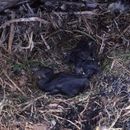Biology
provided by Arkive
Like the cormorant, the shag mainly feeds on fish, but it fishes in deeper water (3) and prefers different prey species (2). It dives for fish from the surface of the water with a pronounced leap (1).
The nest is located on offshore islands, rocky stacks and cliff ledges (8). It is made of twigs and rotting seaweed, and is said to have an extremely pungent smell that increases in intensity as the decomposition of the seaweed continues (3). After hatching, the chicks stay in the nest for 8 weeks (5).
Shags tend not to travel great distances, adults usually remain within 100km of the breeding area, but juveniles move up to 200 km (2). Occasionally a phenomenon known as a 'wreck' occurs, when adverse weather conditions drift birds inland, where they become stranded in unusual habitats. This results in very high mortality for immature birds (2).
Conservation
provided by Arkive
There is no conservation action directly targeted at this species. However, many populations occur within protected reserves, and like all wild birds, the shag is protected by the Wildlife and Countryside Act (4).
Description
provided by Arkive
This bird is very similar in general appearance to the cormorant (Phalacrocorax carbo), but is smaller and slightly slimmer (1). In breeding condition, adults develop a green gloss to the black plumage, and a black crest develops on the head (1). Outside of the breeding season, the plumage is duller and the bill is more yellow in colour (1), although there is a yellow patch at its base throughout the year (3). Juveniles have dark brown upperparts and pale underparts with a white chin (1). A variety of grunting and clicking calls are produced (1). The common name originates from the Old Norse word 'skegg' meaning beard, and refers to the crest (3).
Habitat
provided by Arkive
Breeds in loose colonies (1) on rocky coastal cliffs and islands (2). Nests are made in crevices, under boulders or in small caves (1).
Range
provided by Arkive
The shag is generally a coastal bird, and occurs inland less often than the cormorant. It has a wide distribution around the coastline of Britain (2).
Status
provided by Arkive
Receives general protection under the Wildlife and Countryside Act 1981. Classified as a species of conservation concern by the UK Biodiversity Action Plan, although not a priority species (2). Included in the Birds of Conservation Concern Amber List (medium conservation concern) (7).
Threats
provided by Arkive
Shags are not threatened at present; however, manmade disasters such as oil spills are potentially extremely damaging, and can result in high local mortality (8).

